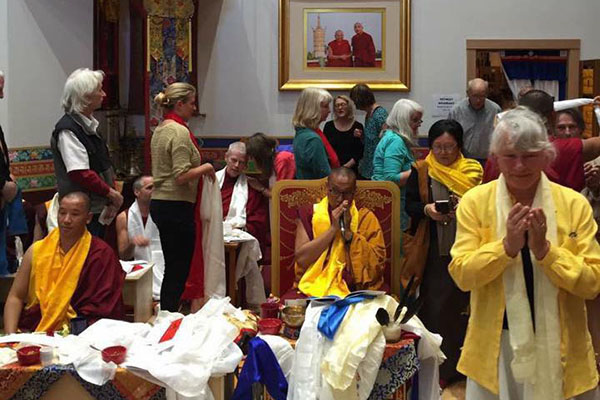
It is traditional to offer a khata (scarf) to a teacher after the last session of a teaching, or the last one you attend, often with a monetary offering in an envelope. It is a simple gesture of respect and thanks, with a protocol of its own. Remember, too, one gives as one is able, your intention is most important.
At KSK, usually a member of KSK presents the first khata with an offering from the center and a request to return. Then others may stand and offer their own khatas and envelopes.
Khatas are made of cotton, silk or other materials. They are the size of a long scarf and have auspicious symbols or mantras inscribed or woven into the fabric. This represents the sincerity of one’s offering, free from negative thoughts or personal motives. Khatas come predominantly in shades of white or ivory, for purity, but you will also find them in blue, red, green, and yellow/gold to represent the five elements.
Traditionally you first fold the khata in half length-wise. This represents interdependence. You fold the scarf into seven folds, and roll the remainder over the folded part into a loose roll, unfurling it before you offer it. (It helps to have two people do the rolling.) The open edges face the teacher; the folded section will be towards you, representing your open pure heart.
SHOWING RESPECT/GRATITUDE
For holy sites, honored monks, teachers, dignitaries and elders, the scarf is given with folded hands near your forehead, with a humble bow toward them, with head bent over and palms joined in respect. [You never put the Khata over their neck in this situation.] In most cases the teacher will place the khata over your neck, as a blessing. On some occasions, the kathas are left on the teacher’s table. (Follow the lead of those before you.)
It is customary to put khatas over statues, thangka paintings, pictures of reincarnated Rinpoches and altars. Khatas are also flown and placed on Prayer Flags as a sign of your prayers being sincere and pure, and also for swift accomplishment of prayers and wishes.
Information about khatas is available online at Tibetan Prayer Flags & Shakyamuni Buddhist Center of Portland.
